____________________________________
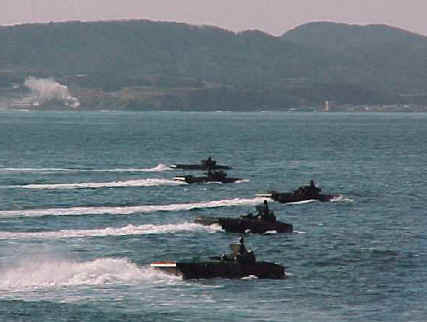 Over
the past few decades, the US Marine Corps has focused funding on expensive new weapons
platforms
at the expense of better weaponry. Billions of dollars were spent on the failed
AAAV/EFV program, and now a less ambitious Amphibious
Combat Vehicle (ACV) is under development. This will require billions more dollars to produce a
thousand replacements for the proven AAV "amtrack." This new vehicle may prove far more
expensive and provide no greater capability. A truly urgent priority is to develop
variants of the AAV. While most APCs were modified into a dozen variants, there
are only two AAV variants; a Command and a Recovery. The US Army developed 29
variants of its M113
APC!
The Marines urgently need to modify some AAVs as 120mm mortar carriers and SPAAGs.
Over
the past few decades, the US Marine Corps has focused funding on expensive new weapons
platforms
at the expense of better weaponry. Billions of dollars were spent on the failed
AAAV/EFV program, and now a less ambitious Amphibious
Combat Vehicle (ACV) is under development. This will require billions more dollars to produce a
thousand replacements for the proven AAV "amtrack." This new vehicle may prove far more
expensive and provide no greater capability. A truly urgent priority is to develop
variants of the AAV. While most APCs were modified into a dozen variants, there
are only two AAV variants; a Command and a Recovery. The US Army developed 29
variants of its M113
APC!
The Marines urgently need to modify some AAVs as 120mm mortar carriers and SPAAGs.
The current AAV-P7/A1 first arrived in 1972 (pictured) and is based on decades of improvements and remains an optimal design for a metal boat that can operate in rough seas and function as an APC ashore. While some APCs are amphibious, they are not designed to return upright if rolled over by waves like the AAV. This is important in rough seas or when an amtrack must leap several feet into the water off a ship ramp. Watch this video of an AAV demonstrating its stability by leaping off a pier, something its replacement is unlikely to attempt. AAVs have been upgraded and overhauled several times and a survivability upgrade has begun that will cost $1.65 million per vehicle. This will be applied to roughly 40% of the 1064 vehicle AAV fleet to keep them in service another 20 years.
Before this program ends, the Marine Corps hopes the new ACV will be in production. But the ACV does not promise any major improvements and its production costs may prove outrageous. This will not be a problem because there is nothing wrong with the current AAV design! It uses the same engine and suspension as the US Army's Bradley APC, which provides tremendous logistical efficiency worldwide. If the ACV is unaffordable, the Marines should simply upgrade and rebuild more AAVs.
Meanwhile,
the Marines need to modify some AAVs as
120mm mortar carriers and SPAAGs. Their loss to the AAV transport fleet can be replaced with armored trucks. The Marines have
lots of AAVs on pre-positioned ships destine to off-load
at ports to be employed as APCs. Some armored ground transport can be
done with trucks that cost far less to procure and maintain. They are more reliable, use far less fuel,
are more comfortable for troops, and provide
greater protection from mines due to their much higher ground clearance. The
Corps' MRAPs and AMK23 7-ton armored trucks
(pictured) can replace some AAVs now dedicated to non-amphibious
transport missions so those can be modified into needed AAV variants.
AAV Mortar Carrier 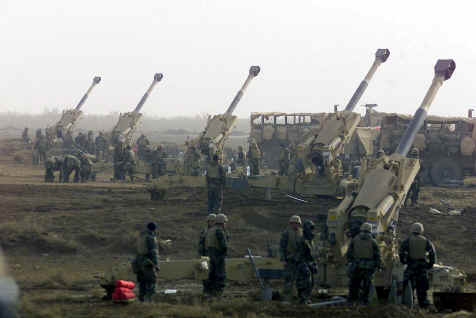
A frequent criticism after peacetime Marine Corps amphibious exercises is the long delay in setting up towed 155mm howitzers to provide fire support. They arrive by landing craft and are towed ashore by wheeled trucks that often become stuck in soft sand and mud. A large, level open area is required to set up the howitzers and time is needed to offload their ammo from trucks. During wartime, none of this can begin until the landing beach and a large firing position is clear of direct enemy fire.
In summary, once the first Marine hits the beach, artillery fire support is not available until at least an hour later, assuming the landing force has pushed inland several hundred meters to suppress enemy fire, to include elusive snipers and light mortars. In the past, Marines relied heavily on naval gunfire. However, the US Navy only has 5-inch guns nowadays with a 13-mile range and wants to keep them much further offshore because of threats from anti-ship missiles. As a result, naval gunfire support may be unavailable and howitzer support will unavailable until an hour or more after landing, during the most intense fighting! Once howitzers begin firing, Marines will pray the enemy lacks counter-battery radar because counter-battery fire can wipe out exposed howitzers with their big crews and unprotected ammunition stores.
The Marines desperately need an AAV-M; a 120mm mortar carrier variant. This simple modification should have appeared 40 years ago! If AAV-Ms are available, Marines who hit the beach can expect heavy fire support immediately after AAV-Ms hit the beach. In many cases, this can occur before infantry hit the beach if AAV-Ms can land on a tiny offshore island, sandbar, or reef to begin fire missions. In addition, AAV-Ms can instantly advance with the landing force to provide fire support while protected by armor from enemy snipers and counter-battery fire.
This is not to suggest the Corps replace all 11 (8 active / 3 reserve) 155mm towed howitzer battalions, but the value of replacing at least two with AAV-M battalions is obvious. These will prove more valuable to deployed MEUs since AAV-Ms need less ship space and are far more mobile for rapid reaction missions. Tracked AAVs with heavy mortars are valuable to armored forces since wheeled trucks towing wheeled howitzers have a limited off-road capability and are often unable to follow advancing tracked tanks. In addition, an advancing AAV-M can halt and execute a fire mission in a minute, whereas a towed 155mm howitzer needs at least ten minutes to set up and fire.
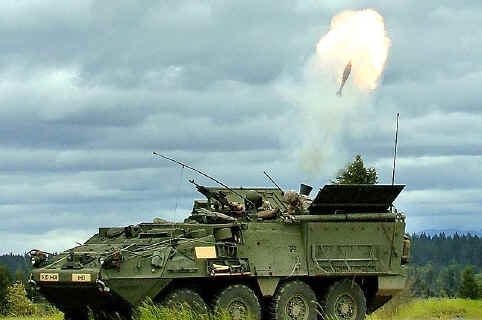
The needed 120mm mortar carrier technology was developed and proven by the US Army many years ago. It currently uses the M1064 mortar carrier mounted in the M-113 (pictured above left) and the M1129 Mortar Carrier mounted in the Stryker vehicle. (pictured above right) Installing either of these proven systems in an AAV is simple since AAVs have greater cargo space. An AAV-M is long overdue!
AAV SPAAG
The US Army and Marine Corps now recognize the need for Self-Propelled Anti-Aircraft Guns (SPAAGs) to fight peer adversaries, yet have none! These are key weapons on the modern battlefield to destroy threats like: attack aircraft, attack helicopters, incoming ATGMs, UAV, and APCs. Here is a good video overview of modern SPAAGs around the world. As rows of amtracks make a long, slow journey toward shore, they are sitting ducks for modern precision-guided missiles and guns fired from shore. Small helicopters and UAVs may slip in under the air cap and attack. Amtracks need organic SPAAG protection from these threats as their .50 cal machine guns lack the needed range and power.
Modifying a few dozen AAVs into AAV-AAGs could be accomplished by mounting a proven AAG weapons turret, without a requirement to leave space for infantrymen. These are also needed to support tank battalions and protect airfields and port facilities from aerial attack. AAV-AAGs could also be placed on the decks of combat ships and transports when needed to provide anti-aircraft, anti-missile, and anti-boat firepower.
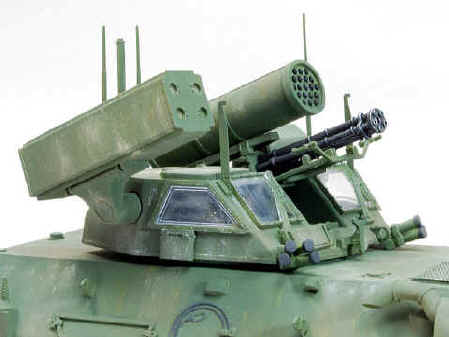 The US Marine Corps developed an impressive
LAV-AD
with a 25mm gatling gun and Stinger or Hydra missiles
mounted on a Blazer turret. (pictured) The vehicle was expensive since
only 17 were procured and these were retired as the Cold War ended. Generals
didn't recognize its secondary value as an anti-armor weapon. Ironically, it
used the same GAU-12 gatling gun found on the Marine Corps AV-8 Harrier that was
promoted as an anti-armor weapon during development. Watch this rare
footage that shows what a 25mm gatling gun can do to a tank.
The US Marine Corps developed an impressive
LAV-AD
with a 25mm gatling gun and Stinger or Hydra missiles
mounted on a Blazer turret. (pictured) The vehicle was expensive since
only 17 were procured and these were retired as the Cold War ended. Generals
didn't recognize its secondary value as an anti-armor weapon. Ironically, it
used the same GAU-12 gatling gun found on the Marine Corps AV-8 Harrier that was
promoted as an anti-armor weapon during development. Watch this rare
footage that shows what a 25mm gatling gun can do to a tank.
Blazer turrets were usually fitted with two four-packs of Stinger missiles, but those could be replaced with Hydra rocket launchers. Fitting a pair of Hellfire or TOW missiles on either arm could provide anti-tank/anti-bunker capabilities. The Blazer gun is stabilized to allow it to fire accurately while on the move. This would allow an AAV-AAG to fire a 25mm gatling accurately while in the water if seas are fairly calm. Air and naval superiority are prerequisites before an amphibious landing begins, but a landing force may be surprised by the sudden appearance of small boats, small helicopters, and UAVs. Otherwise, a 25mm gatling gun and Hydra rockets are valuable to blast enemy positions ashore, destroy armored vehicles, and disable tanks.
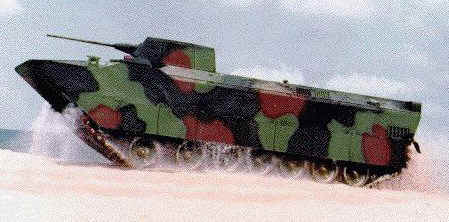 Another
option is the 30mm autocannon developed for the AAAV. (pictured) That vehicle was
to also carry a standard infantry squad, resulting in a huge, costly vehicle. This 30mm autocannon system could be mounted
on
current AAVs
that would carry no troops. The US Navy adopted this same gun for its new LPD-17s,
known as the Mk 46. It is a two-axis stabilized chain gun
that can fire up to 250-rounds per minute. The system uses a forward looking
infrared sensor, a low light television camera, and laser range finder with a
closed-loop tracking system to optimize accuracy against small, high-speed
surface targets. However, this is not an effective anti-air system since it
lacks the rapid fire capability of a gatling gun and has no radar, although one
could be added.
Another
option is the 30mm autocannon developed for the AAAV. (pictured) That vehicle was
to also carry a standard infantry squad, resulting in a huge, costly vehicle. This 30mm autocannon system could be mounted
on
current AAVs
that would carry no troops. The US Navy adopted this same gun for its new LPD-17s,
known as the Mk 46. It is a two-axis stabilized chain gun
that can fire up to 250-rounds per minute. The system uses a forward looking
infrared sensor, a low light television camera, and laser range finder with a
closed-loop tracking system to optimize accuracy against small, high-speed
surface targets. However, this is not an effective anti-air system since it
lacks the rapid fire capability of a gatling gun and has no radar, although one
could be added.
A 40mm autocannon can provide twice the range and explosive power. The 30mm was better for the AAAV since that allowed twice as many rounds to be carried compared to a 40mm, which was important as they would not have a .50 cal. MG and 40mm AGL. In addition, space was needed for the infantry squad. Since an AAV-AAG will be a supporting system and AAVs have great anti-infantry weaponry, more range and firepower is desirable. The proven Bofors LVK90 40mm autocannon turret (pictured) is ideal and includes a compact radar system.
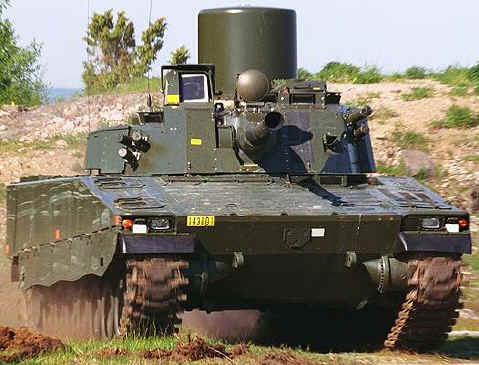 However,
this proven gun is not used elsewhere in the US military, nor
is 40mm ammunition. This
would be a more expensive option because of the added logistics burden, unless the Army or Navy adopt this excellent gun too. Since
the Navy worries about anti-ship missiles, upgrading its 30mm guns to
radar-guided 40mm guns should be considered. The Navy's new LCS wasn't planned with a 76mm gun
common on frigates, it has just a Bofors 57mm. Two Mk 46 30mm autocannon
were added, but lack radar to shoot down strafing aircraft and incoming
missiles. A 40mm stabilized
gun with radar can perform this task with twice the range and power.
However,
this proven gun is not used elsewhere in the US military, nor
is 40mm ammunition. This
would be a more expensive option because of the added logistics burden, unless the Army or Navy adopt this excellent gun too. Since
the Navy worries about anti-ship missiles, upgrading its 30mm guns to
radar-guided 40mm guns should be considered. The Navy's new LCS wasn't planned with a 76mm gun
common on frigates, it has just a Bofors 57mm. Two Mk 46 30mm autocannon
were added, but lack radar to shoot down strafing aircraft and incoming
missiles. A 40mm stabilized
gun with radar can perform this task with twice the range and power.
The US Army is currently evaluating SPAAGs and the LVK90 turret is a good candidate to mount on its big Bradley APCs. These would easily outclass guns on European light armored vehicles and outrange attack helicopter guns. In addition, the 40mm is the smallest round that can include a proximity fuze and enough explosive power for an effective anti-aircraft bursting round.
Choose a Proven Weapons Systems
Any of the three SPAAGs described above would prove effective on an AAV. Each has advantages and disadvantages, but any choice can provide a needed capability at little cost since these are proven systems. SPAAGs are the most versatile ground combat weapon on the modern battlefield. The Marine Corps needs AAV-AAGs to help protect AAVs during their long, slow, open charge to the beach, and AAV-Ms to provide immediate fire support. Fielding these AAV variants must become a priority higher than an AAV replacement. Better weaponry is more important than new platforms!
Carlton Meyer editorG2mil@Gmail.com
©2017 www.G2mil.com